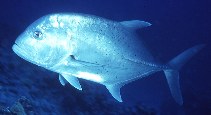| Family: |
Carangidae (Jacks and pompanos), subfamily: Caranginae |
| Max. size: |
170 cm TL (male/unsexed); max.weight: 80 kg |
| Environment: |
reef-associated; brackish; marine; depth range 10 - 188 m |
| Distribution: |
Indo-Pacific: Red Sea and east coast of Africa to the Hawaiian and Marquesan islands, north to southern Japan (Ref. 559) and the Ogasawara Islands, south to northern Australia. Hybrid with Caranx melampygus found in Hawaii (Ref. 58422). |
| Diagnosis: |
Dorsal spines (total): 9-9; Dorsal soft rays (total): 18-21; Anal spines: 3-3; Anal soft rays: 15-17; Vertebrae: 24-24. This species is distinguished by the following characters: gill rakers (including rudiments) 5-7 + 15-17 = 20-24; breast naked ventrally, typically with a small to large patch of prepelvic scales; colour in life of adults, head and body silvery grey to black above, usually paler below; fins usually uniformly grey to black, fish from turbid coastal waters often with yellow fins, the anal fin usually brightest (Ref. 9894).
Description: Body oblong and compressed, dorsal profile strongly convex anteriorly, ventral profile slightly convex. Adipose eyelid moderately developed, small anteriorly, posterior adipose eyelid extends onto eye to rear border of pupil. End of upper jaw extends to posterior edge of pupil or a little beyond. Upper jaw with outer row of strong canines widely spaced in adults, and an inner band of small villiform teeth, widest at symphysis; lower jaw with a single row of strong conical teeth widely spaced in adults (Ref. 9894, 90102). |
| Biology: |
Adults are pelagic over sand and rock (Ref. 58302). They occur singly and inhabit clear lagoon and seaward reefs (Ref. 9710). They feed on crustaceans (like crabs and spiny lobsters) and fishes at night (Ref. 4887). Juveniles are found in estuaries. Large individuals may be ciguatoxic. The largest trevally reaches 1.7 m in length and a weight of over 60 kg (Ref. 48635). Spawning occurs on shallow seaward reefs and offshore banks (Ref. 37816). Sold mostly fresh and dried salted. |
| IUCN Red List Status: |
Least Concern (LC); Date assessed: 09 March 2015 Ref. (130435)
|
| Threat to humans: |
reports of ciguatera poisoning |
Source and more info: www.fishbase.org. For personal, classroom, and other internal use only. Not for publication.
